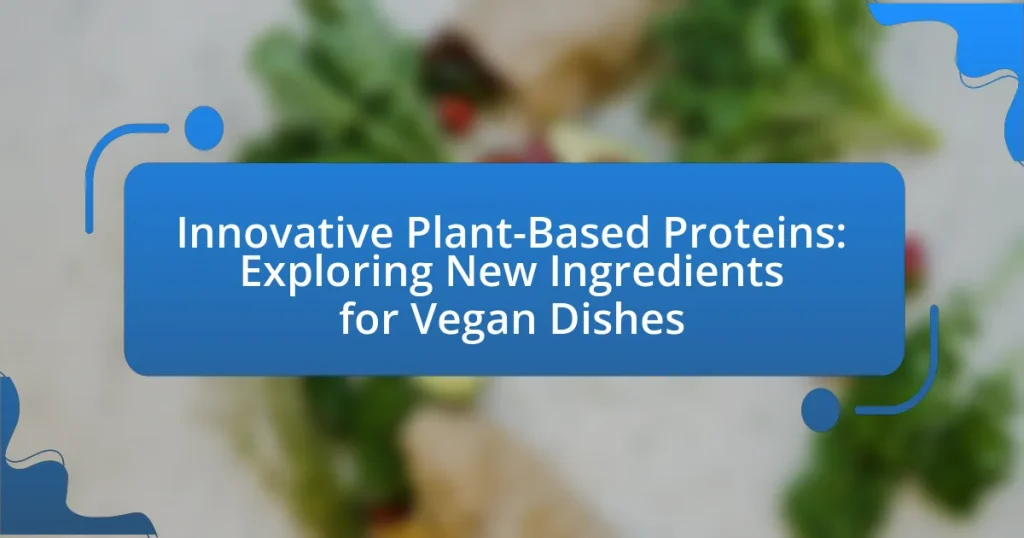Innovative plant-based proteins are advanced protein sources derived from plants, such as pea, lentil, and mycoprotein, designed to enhance the nutritional value and versatility of vegan dishes. These proteins differ from traditional animal-based proteins in their composition and source, often requiring combinations to achieve a complete amino acid profile. The article explores the characteristics, benefits, and culinary applications of these proteins, highlighting their growing popularity due to health and environmental considerations. Additionally, it discusses the various sources of plant-based proteins, their nutritional profiles, and the technological advancements shaping their development in the food industry.

What are Innovative Plant-Based Proteins?
Innovative plant-based proteins are new and advanced sources of protein derived from plants, designed to enhance the nutritional profile and culinary versatility of vegan dishes. These proteins often include ingredients such as pea protein, lentil protein, and mycoprotein, which provide essential amino acids and mimic the texture of animal proteins. Research indicates that the global plant-based protein market is projected to reach $27.9 billion by 2025, reflecting a growing consumer demand for sustainable and health-conscious food options.
How do Innovative Plant-Based Proteins differ from traditional proteins?
Innovative plant-based proteins differ from traditional proteins primarily in their source and composition. Traditional proteins are typically derived from animal products, such as meat, dairy, and eggs, which contain all essential amino acids in sufficient quantities. In contrast, innovative plant-based proteins are sourced from plants like peas, lentils, and quinoa, often requiring combinations to achieve a complete amino acid profile. For instance, pea protein is rich in lysine but low in methionine, while rice protein is the opposite; together, they can provide a balanced amino acid profile. Additionally, innovative plant-based proteins often contain higher fiber content and lower saturated fat levels compared to traditional proteins, contributing to various health benefits.
What are the key characteristics of Innovative Plant-Based Proteins?
Innovative plant-based proteins are characterized by their high nutritional value, versatility in culinary applications, and sustainability. These proteins often contain essential amino acids, making them comparable to animal proteins in terms of nutrition. For example, ingredients like pea protein and quinoa provide complete protein profiles. Additionally, innovative plant-based proteins can be easily incorporated into various dishes, enhancing texture and flavor without compromising dietary preferences. Their production typically has a lower environmental impact compared to traditional animal farming, contributing to reduced greenhouse gas emissions and resource use. This combination of nutritional benefits, culinary flexibility, and sustainability makes innovative plant-based proteins a significant advancement in the food industry.
Why are these proteins gaining popularity in vegan dishes?
These proteins are gaining popularity in vegan dishes due to their high nutritional value and versatility in cooking. Innovative plant-based proteins, such as pea protein, lentils, and quinoa, provide essential amino acids and are often more sustainable than animal-based proteins. For instance, pea protein contains about 25 grams of protein per 100 grams and is known for its digestibility and low allergenic potential, making it an attractive option for many consumers. Additionally, the rise in consumer awareness regarding health and environmental issues has led to increased demand for plant-based diets, further driving the popularity of these proteins in vegan cuisine.
What types of Innovative Plant-Based Proteins are available?
Innovative plant-based proteins include pea protein, soy protein, lentil protein, chickpea protein, and hemp protein. Pea protein is derived from yellow peas and is known for its high protein content and digestibility. Soy protein, extracted from soybeans, is a complete protein containing all essential amino acids. Lentil protein offers a rich source of protein and fiber, while chickpea protein is gaining popularity for its versatility and nutritional benefits. Hemp protein, sourced from hemp seeds, provides a good balance of omega fatty acids and protein. These proteins are increasingly used in various vegan dishes to enhance nutritional profiles and improve texture.
What are the most common sources of these proteins?
The most common sources of innovative plant-based proteins include legumes, nuts, seeds, whole grains, and certain vegetables. Legumes such as lentils, chickpeas, and black beans are rich in protein and widely used in vegan dishes. Nuts and seeds, including almonds, chia seeds, and hemp seeds, provide essential amino acids and healthy fats. Whole grains like quinoa and brown rice also contribute significant protein content. Additionally, vegetables such as spinach and broccoli offer smaller amounts of protein but are valuable in a balanced diet. These sources are recognized for their nutritional benefits and versatility in plant-based cooking.
How do different sources impact the nutritional profile?
Different sources significantly impact the nutritional profile by varying in macronutrient composition, micronutrient availability, and bioactive compounds. For instance, legumes provide high protein and fiber content, while nuts offer healthy fats and essential vitamins. Research indicates that quinoa, a complete protein, contains all nine essential amino acids, making it nutritionally superior compared to many other plant sources. Additionally, the presence of phytochemicals in certain plant-based foods can enhance health benefits, such as antioxidants in berries. Thus, the choice of plant-based protein sources directly influences the overall nutritional quality of vegan dishes.
What are the benefits of using Innovative Plant-Based Proteins in vegan cooking?
Innovative plant-based proteins offer numerous benefits in vegan cooking, including enhanced nutritional profiles, improved texture, and greater culinary versatility. These proteins, derived from sources like peas, lentils, and quinoa, provide essential amino acids, making them comparable to animal proteins in terms of nutrition. For instance, pea protein contains high levels of branched-chain amino acids, which are crucial for muscle growth and recovery. Additionally, innovative plant-based proteins can mimic the texture of meat, allowing for the creation of satisfying dishes that appeal to both vegans and non-vegans. This versatility enables chefs to experiment with flavors and cooking techniques, leading to a broader range of delicious and nutritious vegan options.
How do these proteins contribute to a balanced diet?
Proteins contribute to a balanced diet by providing essential amino acids necessary for bodily functions, muscle repair, and overall health. Plant-based proteins, such as those derived from legumes, nuts, and grains, offer a complete amino acid profile when combined, ensuring that individuals receive all the necessary nutrients. Research indicates that diets rich in plant-based proteins can lower the risk of chronic diseases, such as heart disease and diabetes, while also supporting weight management due to their high fiber content, which promotes satiety.
What environmental advantages do they offer compared to animal proteins?
Plant-based proteins offer significant environmental advantages compared to animal proteins, primarily by reducing greenhouse gas emissions, land use, and water consumption. For instance, producing plant-based proteins generates up to 90% less greenhouse gas emissions than animal farming, as reported by the Food and Agriculture Organization. Additionally, plant-based protein sources require substantially less land; for example, producing one kilogram of beef requires approximately 20 times more land than producing one kilogram of lentils. Water usage is also drastically lower; it takes about 1,800 gallons of water to produce one pound of beef, while only 200 gallons are needed for a pound of soybeans. These factors collectively highlight the environmental benefits of choosing plant-based proteins over traditional animal proteins.

How can Innovative Plant-Based Proteins be incorporated into vegan dishes?
Innovative plant-based proteins can be incorporated into vegan dishes by utilizing ingredients such as pea protein, lentil protein, and mycoprotein, which enhance the nutritional profile and texture of meals. For example, pea protein can be added to smoothies or baked goods to increase protein content without altering flavor significantly. Lentil protein can be used in soups and stews, providing a hearty texture and rich flavor. Mycoprotein, derived from fungi, can serve as a meat substitute in dishes like tacos or burgers, offering a similar mouthfeel to animal protein. These ingredients not only contribute essential amino acids but also align with the growing demand for sustainable food sources, as plant-based proteins generally have a lower environmental impact compared to animal proteins.
What are some popular recipes featuring Innovative Plant-Based Proteins?
Popular recipes featuring innovative plant-based proteins include chickpea flour pancakes, lentil and quinoa salad, and tempeh stir-fry. Chickpea flour pancakes, made from ground chickpeas, are high in protein and fiber, providing a nutritious breakfast option. Lentil and quinoa salad combines these two protein-rich ingredients, offering a complete amino acid profile and a hearty meal. Tempeh stir-fry utilizes fermented soybeans, which are rich in protein and probiotics, making it a flavorful and healthy dinner choice. These recipes highlight the versatility and nutritional benefits of innovative plant-based proteins in vegan cooking.
How can these proteins enhance flavor and texture in dishes?
Plant-based proteins enhance flavor and texture in dishes by providing umami, improving mouthfeel, and contributing to overall dish complexity. For instance, ingredients like pea protein and soy protein can mimic the texture of meat, creating a satisfying chewiness that appeals to consumers seeking plant-based alternatives. Additionally, these proteins can absorb and retain flavors from spices and marinades, enriching the overall taste profile of the dish. Research shows that the incorporation of plant-based proteins can lead to a more balanced flavor experience, as they often contain amino acids that enhance savory notes, making dishes more palatable and enjoyable.
What cooking techniques work best with these proteins?
The best cooking techniques for innovative plant-based proteins include steaming, sautéing, grilling, and baking. Steaming preserves nutrients and enhances the natural flavors of proteins like tempeh and seitan. Sautéing allows for quick cooking while developing a rich flavor profile, particularly effective for tofu and legumes. Grilling adds a smoky taste and appealing texture, suitable for marinated plant-based proteins. Baking is ideal for creating crispy textures in products like chickpea patties or lentil loaves. These techniques are supported by culinary practices that emphasize flavor enhancement and nutrient retention in plant-based cooking.
What challenges might arise when using Innovative Plant-Based Proteins?
Innovative plant-based proteins may face challenges such as texture and flavor matching to traditional animal proteins. These proteins often require extensive processing to achieve desirable sensory attributes, which can lead to higher production costs. Additionally, some consumers may have concerns regarding the nutritional completeness of plant-based proteins compared to animal sources, as certain essential amino acids may be less abundant. Furthermore, the sourcing of these proteins can raise sustainability issues, particularly if they rely on monoculture farming practices that can harm biodiversity.
How can one overcome common cooking challenges with these proteins?
To overcome common cooking challenges with innovative plant-based proteins, one can utilize specific techniques tailored to each protein type. For instance, using aquafaba as an egg substitute can help achieve desired textures in baking, while marinating tofu in flavorful liquids enhances its taste and reduces its blandness. Additionally, incorporating binding agents like flaxseed meal or chia seeds can improve the consistency of plant-based burgers, preventing them from falling apart during cooking. These methods are supported by culinary practices that emphasize flavor enhancement and texture improvement, making plant-based proteins more versatile and appealing in vegan dishes.
What are the potential allergens associated with certain plant-based proteins?
Certain plant-based proteins can be associated with allergens, including soy, wheat, and legumes. Soy protein is a common allergen, affecting approximately 0.4% of the population, particularly in children. Wheat, which contains gluten, can trigger reactions in individuals with celiac disease or wheat allergy, impacting about 1% of the population. Legumes, such as peanuts and lentils, can also cause allergic reactions; peanuts alone affect around 1-2% of individuals, with reactions ranging from mild to severe. These allergens highlight the importance of labeling and awareness in plant-based protein products.

What future trends are emerging in the field of Innovative Plant-Based Proteins?
Future trends in the field of innovative plant-based proteins include the development of alternative protein sources such as fungi, algae, and legumes, which are gaining traction due to their sustainability and nutritional benefits. Research indicates that fungi-based proteins, like mycoprotein, are rich in essential amino acids and have a lower environmental impact compared to traditional animal proteins. Additionally, advancements in food technology are enabling the creation of hybrid products that combine plant proteins with other ingredients to enhance texture and flavor, appealing to a broader consumer base. The global plant-based protein market is projected to reach $27.9 billion by 2025, reflecting a growing consumer demand for healthier and more sustainable food options.
How is technology influencing the development of new plant-based proteins?
Technology is significantly influencing the development of new plant-based proteins by enhancing extraction methods, improving flavor profiles, and enabling the creation of novel protein sources. Advanced techniques such as precision fermentation and genetic engineering allow for the production of proteins that closely mimic animal-derived products in taste and texture. For instance, companies like Impossible Foods utilize yeast fermentation to produce heme, a protein that gives their plant-based burgers a meat-like flavor. Additionally, innovations in food processing technologies, such as high-moisture extrusion, enable the creation of meat analogs with desirable textures. These technological advancements not only expand the variety of plant-based proteins available but also improve their nutritional profiles, making them more appealing to consumers.
What innovations are being made in protein extraction and processing?
Innovations in protein extraction and processing include the development of advanced methods such as enzymatic hydrolysis, membrane filtration, and fermentation techniques. Enzymatic hydrolysis enhances the efficiency of protein extraction from plant sources by breaking down complex proteins into smaller peptides, improving digestibility and functionality. Membrane filtration technologies, like ultrafiltration and microfiltration, allow for the separation of proteins from other components in a more sustainable manner, reducing waste and energy consumption. Fermentation techniques, particularly using microorganisms, are being utilized to produce high-quality proteins from various substrates, enhancing nutritional profiles and flavor profiles of plant-based proteins. These innovations are supported by research indicating that enzymatic processes can increase protein yield by up to 30%, while membrane technologies can reduce extraction time significantly, making them more efficient and environmentally friendly.
How might consumer preferences shape the future of plant-based proteins?
Consumer preferences will significantly shape the future of plant-based proteins by driving demand for diverse, sustainable, and health-oriented options. As consumers increasingly prioritize health, environmental sustainability, and ethical considerations, the plant-based protein market is evolving to meet these needs. For instance, a 2021 report by the Good Food Institute indicated that the plant-based meat market grew by 45% in the U.S. from 2019 to 2020, reflecting a shift in consumer behavior towards plant-based diets. Additionally, surveys show that 70% of consumers are willing to try plant-based alternatives, indicating a strong market potential for innovative ingredients that cater to taste and texture preferences. This consumer-driven evolution will likely lead to the development of new plant-based protein sources and formulations that align with these preferences, ensuring continued growth in the sector.
What practical tips can help in selecting and using Innovative Plant-Based Proteins?
To select and use innovative plant-based proteins effectively, prioritize ingredients with high protein content, such as lentils, chickpeas, and quinoa, which provide essential amino acids. Additionally, consider the texture and flavor profile of the protein source to ensure it complements the dish; for example, tempeh offers a nutty flavor and firm texture, making it suitable for stir-fries. Furthermore, check for allergen information and nutritional labels to avoid potential dietary issues and to ensure a balanced intake of nutrients. Research indicates that incorporating a variety of plant-based proteins can enhance overall dietary quality, as diverse sources contribute different vitamins and minerals essential for health.
How can one ensure a balanced intake of essential amino acids from plant-based sources?
To ensure a balanced intake of essential amino acids from plant-based sources, one should consume a variety of protein-rich foods throughout the day. This approach is necessary because most plant proteins are incomplete, meaning they lack one or more essential amino acids. For instance, legumes like lentils and chickpeas are rich in lysine but low in methionine, while grains such as rice and quinoa provide methionine but are lower in lysine. By combining these foods, such as pairing rice with beans, individuals can achieve a complete amino acid profile. Research indicates that a diverse diet including nuts, seeds, whole grains, and legumes can meet the body’s amino acid requirements effectively, as supported by the findings in “Plant-Based Diets for Cardiovascular Safety and Performance in Endurance Sports” published in the Journal of the American College of Cardiology.
What are the best practices for storing and preparing these proteins?
The best practices for storing and preparing plant-based proteins include keeping them in a cool, dry place and using airtight containers to prevent moisture and spoilage. Proper storage conditions help maintain the nutritional quality and flavor of proteins such as legumes, nuts, and seeds. For preparation, soaking legumes before cooking enhances digestibility and reduces cooking time, while roasting nuts can improve flavor and texture. Research indicates that soaking beans can reduce cooking time by up to 75%, making them more energy-efficient to prepare.


